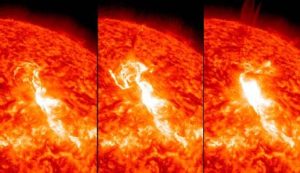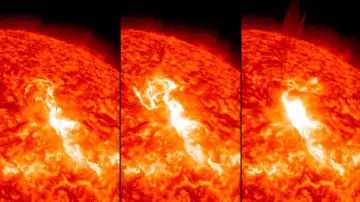
A team of Indian astronomers, who are tracking the continuous evolution of the energy state of the core of a solar eruption that occurred six years ago, have found it strangely maintained a constant temperature as it erupted energetic and highly magnetised plasma from the solar corona into space.
The finding can improve our understanding of how such eruptions can impact communication systems on Earth.
The team comprising Dr. Vaibhav Pant, Prof. Dipankar Banerjee and researcher Jyoti Sheoran from Nainital-based Aryabhatta Research Institute of Observational Sciences (ARIES), and Dr. Ritesh Patel from Southwest Research Institute, Boulder, US, tracked the continuous evolution of the thermodynamic properties of the core of a solar eruption that occurred on July 20, 2017.

In a study published in the journal “Frontiers in Astronomy and Space Sciences”, they estimated the temperature and density of the coronal mass ejection (CME) core and found that strangely the core maintains a constant temperature as it propagates from 1.05 to 1.35 Rsun despite the expected adiabatic cooling due to the expansion of the core.
CMEs are large-scale eruptions of charged particles (plasma) and magnetic fields from the solar atmosphere into space. They can disrupt a range of ground- and space-based technologies and satellites on Earth. This can also help our ability to monitor space weather.
The authors of the study concluded that the expansion of this CME core behaves more like an isothermal than an adiabatic process (thermodynamic process in which there is no exchange of heat from the system to its surrounding).
Thus, it is crucial to understand their evolution and propagation through interplanetary space. To understand the underlying processes, it is important to study the evolution of thermodynamic properties (such as density, temperature, thermal pressure, etc.) of CMEs.
The astromers used data from the ground-based instruments Mauna Loa Solar Observatory (MLSO), K-cronagraph (K-Cor) and Coronal Multichannel Polarimeter (CoMP) as well as data from the space-based Solar Dynamics Observatory (SDO) and Atmospheric Imaging Assembly (AIA) telescopes for the purpose and also established that the density of the CME core decreased by a factor of around 3.6 as it propagated outwards.
In the past, scientists had studied the thermal evolution of CMEs in the solar corona. However, those studies were limited to larger distances from the Sun (more than 1.5 times the radius of the Sun or RSun). However, the evolution of thermodynamic properties of CMEs is not yet well understood, primarily due to the lack of suitable observations in these heights.




 Driving Naari Programme launched in Chandigarh
Driving Naari Programme launched in Chandigarh






























